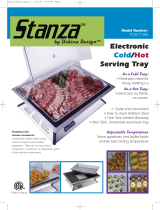
22
Caring for the environment ........................................... 2
Safety instructions ......................................................... 3
Installation ....................................................................... 5
Parts ................................................................................. 7
Control panel .................................................................. 8
Setting the temperature ................................................. 9
Using the handy functions .......................................... 10
Features and functions ................................................ 11
User alert functions ...................................................... 11
Making ice cubes .......................................................... 12
Removing and attaching shelves ................................ 12
Care and Cleaning instructions .................................. 13
FAQs .............................................................................. 15
Specications ............................................................... 17
Disposing of the packaging
Please recycle where possible (e.g. cardboard, plastic bags, adhesive tape and polystyrene) and
make sure you dispose of all other packing materials safely.
Keep the packaging out of the reach of babies and young children, to avoid injury or suffocation.
Information on Disposal for Users of Waste Electrical & Electronic
Equipment (private households)
This symbol on the products and/or accompanying documents means that used electrical and electronic
products should not be mixed with general household waste.
For proper treatment, recovery and recycling, please take these products to designated collection points,
where they will be accepted on a free of charge basis. Alternatively, in some countries you may be able to
return your products to your local retailer upon the purchase of an equivalent new product.
Disposing of this product correctly will help to save valuable resources and prevent any potential negative
effects on human health and the environment which could otherwise arise from inappropriate waste
handling. Please contact your local authority for further details of your nearest designated collection point.
Penalties may be applicable for incorrect disposal of this waste, in accordance with national legislation.
For business users in the European Union
If you wish to discard electrical and electronic equipment, please contact your dealer or supplier for further
information.
Information on Disposal in other Countries outside the European Union
This symbol is only valid in the European Union.
If you wish to discard this product, please contact your local authorities or dealer and ask for the correct
method of disposal.
Before disposing of your old appliance
Please follow either the disposal instructions from the manufacturer of the old appliance, or local disposal
regulations for the appliance. Where this is not available, please follow the three step instructions below.
1. Remove the mains plug from the socket.
2. Cut the mains lead off, and safely dispose of it with the mains plug still attached.
3. Until the old appliance is collected, or you take it to a Recycling Centre, make sure it’s out the
reach of small children.
● Remove all sealing materials from the door and leave all the shelves and drawers in place.
This way, children are less likely to climb in and become trapped.
Caring for the environment
Contents
●This appliance is intended to be used in household and similar applications such as
- staff kitchen areas in shops, ofces and other working environments;
- farm houses and by clients in hotels, motels and other residential type environments;
- bed and breakfast type environments;
- catering and similar non-retail applications.




















